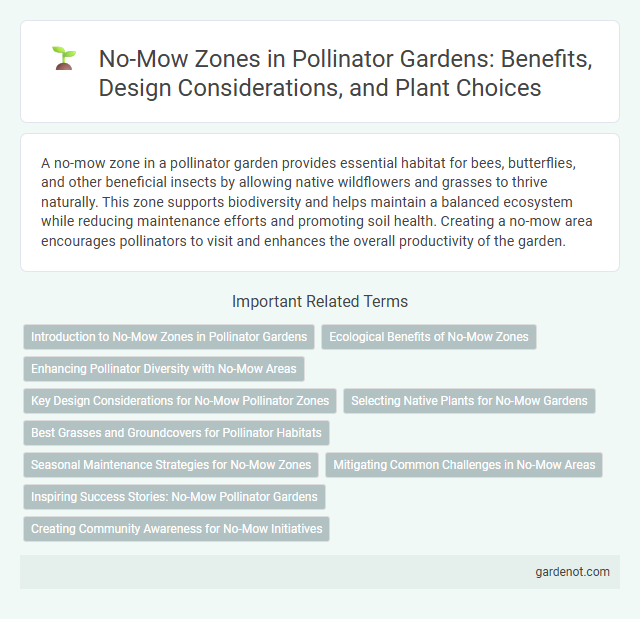A no-mow zone in a pollinator garden provides essential habitat for bees, butterflies, and other beneficial insects by allowing native wildflowers and grasses to thrive naturally. This zone supports biodiversity and helps maintain a balanced ecosystem while reducing maintenance efforts and promoting soil health. Creating a no-mow area encourages pollinators to visit and enhances the overall productivity of the garden.
Introduction to No-Mow Zones in Pollinator Gardens
No-mow zones in pollinator gardens create essential habitats by preserving native wildflowers and grasses that support bees, butterflies, and other pollinators. These areas reduce lawn maintenance while enhancing biodiversity and providing continuous nectar and pollen sources throughout the growing season. Establishing no-mow zones contributes to healthier ecosystems by fostering sustainable pollinator populations crucial for plant reproduction and food production.
Ecological Benefits of No-Mow Zones
No-mow zones significantly enhance biodiversity by providing uninterrupted habitats for native pollinators such as bees, butterflies, and hummingbirds. These areas promote the growth of native wildflowers and grasses, which improve soil health and increase natural pest control. By reducing lawn maintenance, no-mow zones also lower carbon emissions and pesticide usage, fostering a healthier ecosystem.
Enhancing Pollinator Diversity with No-Mow Areas
No-mow zones provide essential habitats that support a wide variety of pollinators, including native bees, butterflies, and other beneficial insects by allowing wildflowers and native plants to flourish naturally. These areas increase floral diversity and extend blooming periods, offering continuous nectar and pollen resources critical for pollinator health. Establishing no-mow zones within pollinator gardens enhances biodiversity and improves ecosystem resilience by reducing habitat disturbance and supporting sustainable pollinator populations.
Key Design Considerations for No-Mow Pollinator Zones
Key design considerations for no-mow pollinator zones include selecting native flowering plants that provide continuous bloom throughout the growing season to support diverse pollinator species. Ensuring soil health with proper aeration and avoiding pesticide use enhances pollinator habitat quality. Strategic placement near water sources and sunlit areas maximizes pollinator activity and plant growth in the garden.
Selecting Native Plants for No-Mow Gardens
Selecting native plants for no-mow zones enhances pollinator habitat by providing essential nectar, pollen, and shelter tailored to local species. Native plants like milkweed, coneflowers, and goldenrod thrive with minimal maintenance, supporting bees, butterflies, and other pollinators throughout the growing season. Establishing these plants reduces lawn care demands while promoting biodiversity and ecosystem health in pollinator gardens.
Best Grasses and Groundcovers for Pollinator Habitats
Selecting native grasses such as Little Bluestem (Schizachyrium scoparium) and Prairie Dropseed (Sporobolus heterolepis) enhances pollinator habitats by providing essential nesting sites and food sources for bees and butterflies. Groundcovers like Creeping Thyme (Thymus serpyllum) and Wild Strawberry (Fragaria virginiana) support diverse pollinator populations by offering nectar-rich blossoms and continuous bloom cycles. Establishing a no-mow zone with these species promotes biodiversity, improves soil health, and sustains pollinator activity throughout the growing season.
Seasonal Maintenance Strategies for No-Mow Zones
Seasonal maintenance strategies for no-mow zones in pollinator gardens include targeted pruning and selective weeding to promote native plant growth and prevent invasive species. Allowing natural leaf litter to decompose supports soil health and provides habitat for pollinators during winter. Monitoring and adjusting plant diversity each season enhances nectar availability and sustains pollinator populations year-round.
Mitigating Common Challenges in No-Mow Areas
Establishing no-mow zones in pollinator gardens addresses habitat disruption by allowing native plants to flourish undisturbed. Managing weed encroachment through selective hand weeding and periodic mowing around edges reduces invasive species competition. Promoting soil health with mulching and organic amendments supports robust plant growth, enhancing pollinator habitat quality despite reduced mowing.
Inspiring Success Stories: No-Mow Pollinator Gardens
No-mow pollinator gardens create thriving habitats by allowing native wildflowers and grasses to flourish, significantly boosting local pollinator populations such as bees, butterflies, and hummingbirds. Success stories from community parks and private yards demonstrate increased biodiversity and reduced maintenance costs due to less frequent mowing and chemical use. These gardens serve as vital sanctuaries in urban and suburban areas, promoting ecological balance and supporting essential pollination services crucial for food production.
Creating Community Awareness for No-Mow Initiatives
Establishing a no-mow zone in pollinator gardens enhances native habitat preservation and boosts biodiversity by supporting essential pollinator species like bees and butterflies. Educating local communities through workshops and informational signage increases awareness of no-mow benefits, fostering grassroots support for sustainable gardening practices. Collaborative efforts with neighborhood associations accelerate adoption, creating interconnected habitats that promote ecological resilience and pollinator health.
No-mow zone Infographic

 gardenot.com
gardenot.com